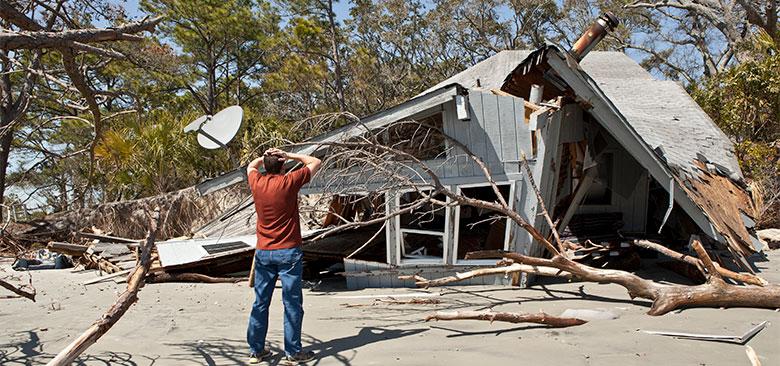
The impacts of climate-related events have been routinely measured in terms of property damage, but a new study co-authored by School of Nursing professor Wendy Max examines the human health costs of climate change (iStock)
What is the Human Cost of Climate Change?
The cost of climate change is often measured in terms of property damage and lost crops, but those expenses don’t provide a complete picture of climate-related impacts. A crucial, but poorly understood, consequence of climate change is the cost to human health – the damage to and loss of human lives from a wide range of environmental risks.
In a new study, UC San Francisco School of Nursing’s Wendy Max, in collaboration with researchers at the Natural Resources Defense Council (NRDC) and Columbia University, analyzed 10 climate change-fueled environmental calamities in 2012, when the U.S. experienced record-setting warmth.
The health costs from those events: $10 billion.
 Wendy Max “This is just the tip of the iceberg,” said Max, a professor of health economics and director of the School of Nursing’s Institute for Health & Aging. “This is written to be a wake-up call.”
Wendy Max “This is just the tip of the iceberg,” said Max, a professor of health economics and director of the School of Nursing’s Institute for Health & Aging. “This is written to be a wake-up call.”
The urgency to mitigate climate change and adapt to its unavoidable impacts is growing as more communities experience devastating events, such as last year’s California wildfires (the state’s deadliest on record) and 2017’s Hurricane Harvey. That storm event caused unprecedented flooding, an impact that a peer-reviewed study shows was worsened by climate change.
To some, climate change’s effects on health may seem like a distant hazard that they won’t have to deal with or pay for in their lifetimes. A goal of this new study, which published Sept. 18 in GeoHealth, is to debunk that myth and acknowledge the immediate and widespread health costs of climate change.
“Our paper sheds light on the variety of climate change impacts on health across the U.S.,” said Vijay Limaye, a science fellow at the NRDC and the study’s lead author, “and we estimate the major costs of those health problems, in terms of lost lives and expensive medical care.”
Examining 10 Climate Events, Stretching From Washington to Florida
The 10 climate-sensitive events the study analyzed were diverse in type and location: wildfires in Colorado and Washington, harmful algal blooms in Florida, Lyme disease in Michigan, Hurricane Sandy in New Jersey and New York, ozone air pollution in Nevada, allergenic oak pollen in North Carolina, extreme weather in Ohio, West Nile Virus outbreak in Texas, and extreme heat in Wisconsin. Climate change is expected to worsen each of those problems in the future to differing degrees.
Their analysis consisted of examining dozens of peer-reviewed health studies, state and federal agency data, and other public reports related to health impacts in 2012. The study’s results are segmented by morbidity, defined as illness or injury occurring from an event, and mortality or deaths occurring from an event.
To calculate morbidity costs, the researchers used federal healthcare cost data such as expenses for hospital admissions and emergency room visits. To determine mortality costs, they employed a metric the Environmental Protection Agency (EPA) uses to determine the “Value of a Statistical Life” (VSL). According to the EPA, the VSL represents an estimate “of how much people are willing to pay for small reductions in their risks of dying from adverse health conditions that may be caused by environmental pollution.” The EPA commonly employs this metric to estimate the economic impacts of damages to human health.
The Health Cost, in Numbers
The 10 events led to 917 deaths, 20,568 hospitalizations, and 17,785 emergency department visits, along with other health-related expenses, totaling nearly $10 billion (in 2018 dollars) in health-related costs. Mortality costs totaled $8.4 billion while morbidity costs, including lost wages, were $1.6 billion. The costliest event was Hurricane Sandy, which resulted in 273 deaths and $3.1 billion in health-related costs. Second were the Washington wildfires, which led to 245 deaths (largely from wildfire-generated dangerous air pollution) and $2.3 billion in health-related costs.
 Because of widespread under-reporting of certain climate-health impacts, especially from events like extreme heat, the researchers estimate the $10 billion figure to be conservative. The authors note that, beyond these 10 events, the national price tag of climate-driven health costs was certainly higher.
Because of widespread under-reporting of certain climate-health impacts, especially from events like extreme heat, the researchers estimate the $10 billion figure to be conservative. The authors note that, beyond these 10 events, the national price tag of climate-driven health costs was certainly higher.
Some climate events in the study resulted in no fatalities. For example, no deaths were associated with the algal blooms in Florida where “red tides” form when marine algae grow out of control in the warm freshwaters in and around the state. But the algal blooms were responsible for the second-highest costs in hospital admissions — $400 million — and emergency department visits — $146 million — among the 10 events studied. According to the EPA, climate impacts such as warmer water, higher carbon dioxide levels, and rising sea levels “might cause harmful algal blooms to occur more often, in more waterbodies, and to be more intense.”
“Extreme weather isn’t easy to measure from beginning to end,” Max said. “For certain events, the impact can go on for a while.”
The research also considered a wide range of health impacts linked to climate change. The study, which advanced previous research published in 2011, examined effects such as pregnancy complications, carbon monoxide exposures, and mental health issues – impacts all attributed to Hurricane Sandy. Max said it’s common to forget that one’s experience in a climate-related incident can be the initial trigger leading to mental health issues down the road.
Older adults and children are particularly vulnerable to the negative health impacts of climate change. Medicare accounted for $782 million, or nearly half, of the total $1.58 billion in illness costs of the episodes studied, despite the program insuring only about 16 percent of U.S. older adults in 2012. Hospital visits for asthma care are more common for children, especially those in low-income families—hence the high burden to Medicaid in North Carolina due to the effects of high pollen levels.
While every death, injury, or illness listed in the study cannot be directly linked to climate change, researchers said its influence in worsening human health from these types of exposures is not in question. Take the Lyme disease outbreak in Michigan: Every case of Lyme disease may not be caused by climate change, but Max said climate change plays a role in increasing the risks of disease transmission. In fact, Lyme disease incidence in Michigan increased by a factor of more than 5 between 2000 and 2014, in tandem with an expansion of the tick population.
A Call to Action
The study highlights important issues just days before world leaders gather in New York for the UN Climate Action Summit 2019. The researchers believe the U.S.’s preparedness for climate-sensitive health impacts is “inadequate” and that lawmakers must move forward with concrete policies that address climate change to protect public health.
“It’s important to not think of climate change as a hypothetical, future risk.” Limaye said. It’s here and now, and it’s expensive in terms of irreversible damage to human health and monumental health costs. If we fail to cut the pollution that drives climate change, these health impacts will only grow and accelerate. We’re at a key point to prevent unprecedented suffering around the world.”
Said Max: “Estimating the health-related costs of climate-sensitive events adds a new dimension to our understanding of the potential burden we are facing. It adds new urgency to the need to improve healthcare delivery systems to better address events as they occur, and particularly to consider the needs of vulnerable populations.”




